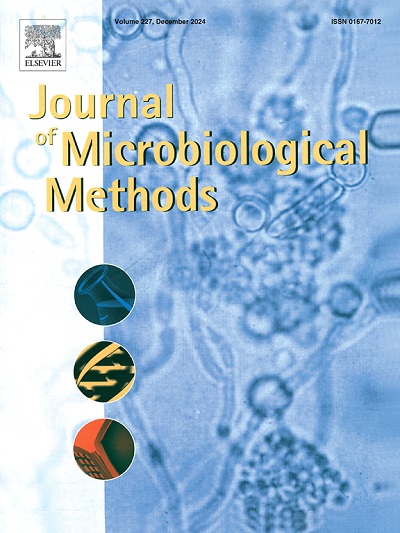Manual and automated bacterial streak plating using permanent magnet-actuated metal balls
IF 1.9
4区 生物学
Q4 BIOCHEMICAL RESEARCH METHODS
引用次数: 0
Abstract
The identification of microorganisms and antimicrobial susceptibility testing usually begins with culture of isolated colonies of the organism by streaking the sample onto petri dishes with appropriate nutrient agar using metal loops. An alternative method of using metal balls actuated by a permanent magnet to successfully perform the streak plate operation was described and demonstrated here. With metal balls of 2.5 mm diameter as carrier of the inoculum, a travel speed of 3 mm/s was found to be optimal for maintaining constant contact with the agar surface and to obtain isolated colonies. In applying this method using both the manual and automated approaches, five repetitions with Escherichia coli and yoghurt samples (likely dominated by Lactobacillus spp) yielded consistent streaking patterns and single colony isolation following incubation. Effective thermal sterilization (180 °C for 3 h) of the used metal balls and restoration of its magnetic properties upon cooling was demonstrated in subsequent streak plating experiments without inoculum.

手动和自动细菌条纹电镀使用永磁体驱动的金属球。
微生物的鉴定和抗菌药敏感性测试通常首先要对分离出的菌落进行培养,方法是使用金属环将样品条染到装有适当营养琼脂的培养皿上。这里描述并演示了一种使用由永久磁铁驱动的金属球来成功执行条纹板操作的替代方法。使用直径为 2.5 毫米的金属球作为接种物的载体,发现 3 毫米/秒的移动速度是保持与琼脂表面持续接触并获得分离菌落的最佳速度。在使用手动和自动方法时,对大肠杆菌和酸奶样品(可能以乳酸杆菌为主)进行了五次重复试验,结果显示培养后的条纹模式和单菌落分离效果一致。在随后的无接种物条纹培养实验中,证明了所用金属球的有效热消毒(180 °C,3 小时)和冷却后磁性的恢复。
本文章由计算机程序翻译,如有差异,请以英文原文为准。
求助全文
约1分钟内获得全文
求助全文
来源期刊

Journal of microbiological methods
生物-生化研究方法
CiteScore
4.30
自引率
4.50%
发文量
151
审稿时长
29 days
期刊介绍:
The Journal of Microbiological Methods publishes scholarly and original articles, notes and review articles. These articles must include novel and/or state-of-the-art methods, or significant improvements to existing methods. Novel and innovative applications of current methods that are validated and useful will also be published. JMM strives for scholarship, innovation and excellence. This demands scientific rigour, the best available methods and technologies, correctly replicated experiments/tests, the inclusion of proper controls, calibrations, and the correct statistical analysis. The presentation of the data must support the interpretation of the method/approach.
All aspects of microbiology are covered, except virology. These include agricultural microbiology, applied and environmental microbiology, bioassays, bioinformatics, biotechnology, biochemical microbiology, clinical microbiology, diagnostics, food monitoring and quality control microbiology, microbial genetics and genomics, geomicrobiology, microbiome methods regardless of habitat, high through-put sequencing methods and analysis, microbial pathogenesis and host responses, metabolomics, metagenomics, metaproteomics, microbial ecology and diversity, microbial physiology, microbial ultra-structure, microscopic and imaging methods, molecular microbiology, mycology, novel mathematical microbiology and modelling, parasitology, plant-microbe interactions, protein markers/profiles, proteomics, pyrosequencing, public health microbiology, radioisotopes applied to microbiology, robotics applied to microbiological methods,rumen microbiology, microbiological methods for space missions and extreme environments, sampling methods and samplers, soil and sediment microbiology, transcriptomics, veterinary microbiology, sero-diagnostics and typing/identification.
 求助内容:
求助内容: 应助结果提醒方式:
应助结果提醒方式:


